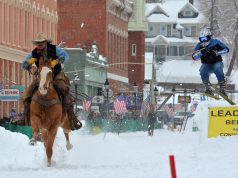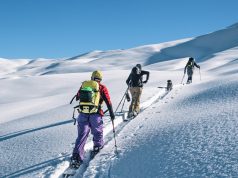
The news spread, like it always does, quickly.
Professional skier Jamie Pierre died Sunday afternoon in an early season avalanche while skiing yet-to-be-opened Snowbird. The Utah resort hadn’t commenced avalanche control work, and the upper parts of the ski area’s steep, avalanche-prone mountain had been getting pounded by snow and wind, filling in lines and enticing local skiers. A thin October snowpack compounded the problem. Conditions were ripe for slides, and through Pierre was a veteran of big mountains and steep terrain, the slide swept him 400 feet though rocky terrain. Unburied, Pierre was a victim of trauma sustained in his ride down the mountain, and died on the scene.
Unfortunately, Pierre made the headlines the wrong way. But the reality is that with winds in excess of 100 mph gusting across Colorado’s mountains this past weekend, and the same kind of thin October snowpack here, the early season backcountry conditions are as dangerous as they’ve been in years. Forget last year, when Colorado kicked off November with a relatively deep and stable snowpack. This year is different, and it’s shaping up to be grim.
Avalanches don’t happen in a vacuum.
They’re the result of complex interactions between terrain, weather and snowfall. Throw in the human element — skiers and snowboarders jonesing for early season powder turns — and you have a converging set of factors that can lead to the worst possible outcome.
There is absolutely no reason why anyone should be caught in an avalanche. If you don’t head into the mountains when they have snow on them, you’re more likely to get struck by lightning than tum bled to your death in an icy wash cycle. But if you ski or snowboard, you will eventually have to deal with the avalanche decision-making process, even if it’s just looking at an avalanche closure rope and deciding to go the other way instead of cutting the closure.
According to Scott Toepfer of the Colorado Avalanche Information Center (CAIC), decision-making is a key part of mitigating the risk of avalanches for backcountry skiers and snowboarders.
A former patroller who has been employed at a wide variety of resorts, from Arapahoe Basin to Courchevel, France, to Mt. Hutt in New Zealand, Toepfer has been with the CAIC since the early ’90s. Toepfer is a skier, and understands the lust for November powder days.
“Everyone is getting jazzed,” Toepfer says of early season snowfall. “The resorts are opening, Warren Miller has had his show in town, and one of the reasons that people live here is to go out into the mountains. But it’s important to back up a step.
“You want to look at a slope and think about what an avalanche will do if you get caught in it,” says Toepfer. “Early season avalanches may not be that deep, but where will they take you?”
According to Toepfer, it is a crucial question.
“Are you going to be taken off of a 100-foot cliff into an old-growth forest or into a deep gully where you’ll be under 18 feet of snow?” Toepfer says. “Being carried into rocks and stumps at 40 or 50 miles per hour isn’t going to make for a very pretty ride.”
And, with November’s thin snowpack, the odds are that most rides won’t be pretty, at least until more storms arrive and terrain gets filled in.
Other choices, says Toepfer, also play a part.
“It’s important to be educated,” he says, as well as have the right equipment. “A carpenter wouldn’t go to work without a hammer, so backcountry skiers and snowboarders absolutely must carry the correct equipment. A beacon, probe, shovel and first aid kit are the bare minimum.”
Toepfer admits that he can sound a bit like Chicken Little.
“I don’t want people to think that I’m running around saying ‘the sky is falling,’” he says of Colorado’s winters and the risk of avalanches. “I don’t want to tell people, ‘Don’t go.’ There will always be safe places to go, places with mellow terrain. But it’s human nature to push the envelope and push their limits. The thing for people to do is to reduce risk. If there’s snow on it, it can slide.”
And, according to Toepfer, the early conditions that we’re experiencing now are pretty ugly.
“The snow we had in October is, for want of a better word, rotten,” he says. “It’s set up as our foundation for the winter, and it doesn’t inspire confidence.”
Along with a rotten October base, the winds arrived in November, as did more snow. In particular, the sustained winds last weekend have moved snow from the higher peaks and ridges to below treeline, creating conditions ripe for avalanches in areas usually considered safe.
“We’re starting to see avalanche formation in unusual places,” says Toepfer.
“And this condition is widespread across the state.”
For backcountry skiers and snowboarders, this creates a strange start to the season. Traditionally, areas below treeline are safer, but currently they could be some of the most dangerous. And this danger can linger.
“There’s very little to hold the snow right now,” says Toepfer. “And the thing we always hear from people caught in avalanches at this time of year is that they say that they never thought there was enough snow to avalanche. Don’t be fooled by grass or other things sticking up from the snow.”
And take your time. “As snow sits on the ground it becomes more comfortable,” says Toepfer. “Give it 24 to 48 hours after a storm, exercise patience. It’s OK to take it slow.”
Respond: [email protected]














